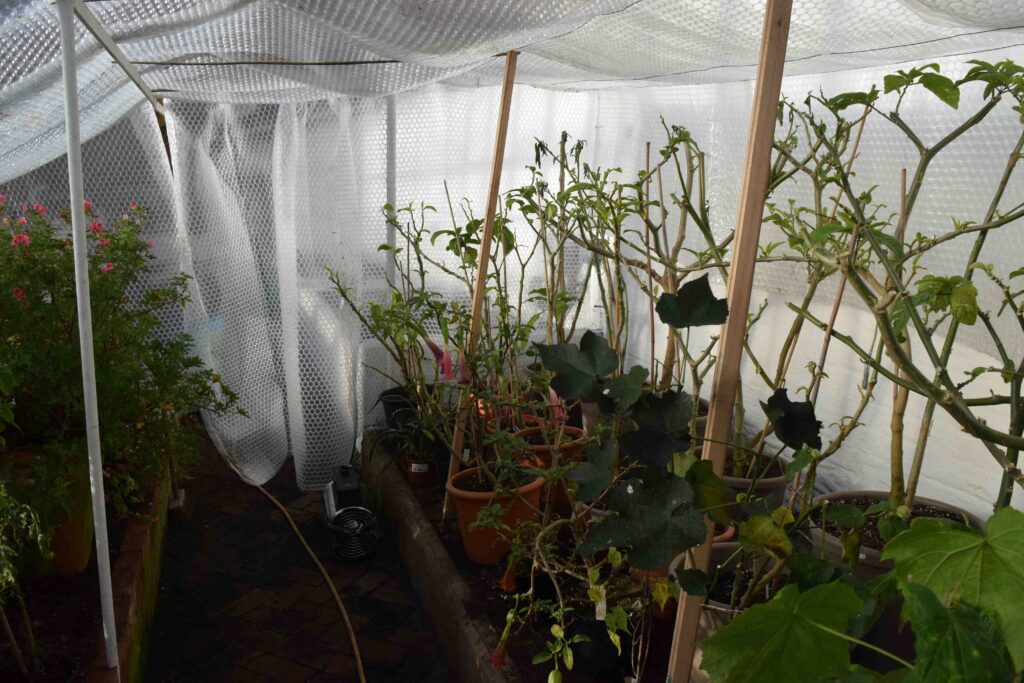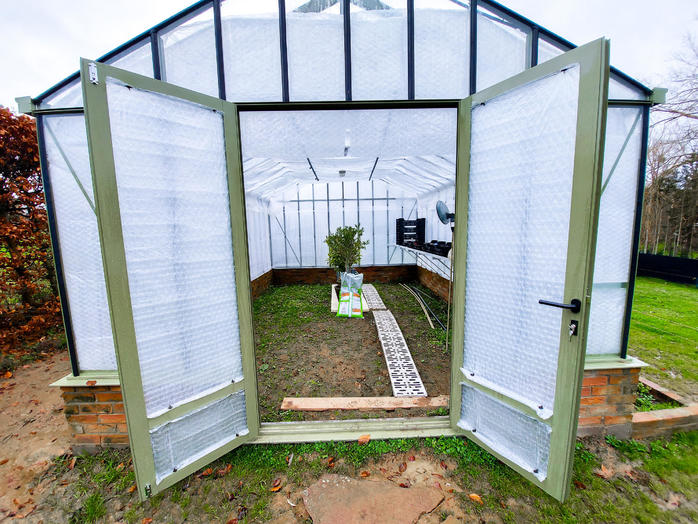As a passionate gardener, my dream has always been to cultivate a thriving garden year-round. To turn this dream into reality, I decided to build a greenhouse in my backyard. However, I soon realized that without proper insulation, maintaining a consistent and favorable environment for my plants would be challenging
Insulating a greenhouse is important for maintaining a stable and controlled climate within the structure, which is crucial for the successful cultivation of plants. Proper insulation helps regulate temperature, humidity, and energy efficiency. Here’s a quick guides on how to insulate a greenhouse:
- Gather materials like insulation material, adhesives, and tape.
- Assess your greenhouse for heat loss areas.
- Choose insulation material based on your climate and R-value.
- Insulate walls and roof using the selected material.
- Seal gaps and vents with weather-resistant tape or sealant.
- Consider thermal curtains for added insulation.
- Monitor and adjust temperature and humidity.
- Install heating in extremely cold climates if necessary.
- Regularly maintain your greenhouse and insulation.
What Materials and Tools are Essential for Greenhouse Insulation?

To ensure optimal temperature control and plant growth in your greenhouse, it’s crucial to have the right materials and tools for insulation.
Insulation Material Options:
Bubble Wrap: This is a cost-effective option. Bubble wrap, when applied with the bubbles facing the greenhouse interior, creates an insulating layer of trapped air, providing decent insulation.
Polyethylene Film: Polyethylene plastic is often used as it’s affordable and easy to install. It can be attached to the frame and provides good insulation by reducing heat loss.
Fiberglass: Fiberglass insulation is effective in retaining heat and is more durable, but it requires careful handling due to its potential to irritate skin and eyes.
Polycarbonate Panels: These are durable, transparent, or translucent panels that offer excellent insulation and UV protection.
Double-Glazed Glass: High-quality glass with two panes separated by a layer of air or gas is an efficient but expensive choice for insulation.
Adhesives, Fasteners, and Tape:
Adhesives: Use appropriate adhesives based on the insulation material and the surface you’re attaching it to. For example, adhesive tape for plastic films and specific adhesives for fiberglass or polycarbonate.
Fasteners: Depending on your greenhouse structure, you may need fasteners like screws, nails, or clips to secure the insulation to the frame securely.
Tape: Weather-resistant and UV-resistant tape is essential for sealing gaps, attaching insulation material, and preventing air leaks.
How to Assess Your Greenhouse for Effective Insulation?
Before diving into greenhouse insulation, a comprehensive assessment of your structure is the vital first step.
Evaluating Existing Conditions:
Check the condition of your greenhouse structure, including the frame, glazing, and any existing insulation. Moreover, look for signs of wear, damage, or rust on the frame, as these can affect insulation.
In addition, ensure that the greenhouse is free from leaks, as moisture can reduce insulation effectiveness.
Identifying Heat Loss Areas:
Examine the greenhouse during different weather conditions, especially cold or windy days.
Note areas where you feel drafts or notice condensation, as these are indicative of heat loss.
Additionally, inspect doors, windows, vents, and any gaps or cracks in the structure for potential heat loss points.
How to Select the Perfect Insulation for Your Greenhouse?
Choosing the ideal insulation for your greenhouse hinges on factors like climate, budget, and the specific needs of your plants.
Considering Climate and R-Values:
- Understand your local climate to determine your insulation needs. Colder climates require higher insulation levels
- R-value measures the insulation material’s effectiveness. Higher R-values indicate better insulation. Choose materials with appropriate R-values for your climate.
Selecting Appropriate Insulation Material:
- Consider factors such as cost, durability, and ease of installation.
- For year-round use, more permanent options like polycarbonate or double-glazed glass may be ideal.
- Temporary solutions like bubble wrap or polyethylene film are cost-effective for seasonal use.
How to Properly Insulate the Walls of Your Greenhouse?
Effectively insulating your greenhouse walls involves a careful selection of materials and meticulous installation techniques.
Attaching Insulation to Interior Walls:
Placement: Install insulation on the interior walls of your greenhouse. This helps create a barrier between the inside and outside temperatures.
Attachment: Use appropriate fasteners, adhesive, or clips to secure the insulation material to the wall. Make sure it is tightly attached but without compressing it excessively.
Overlap: If you’re using multiple pieces of insulation material, overlap the edges to eliminate gaps and ensure a continuous insulating layer.
Ensuring Complete Coverage:
Seal Gaps: Pay special attention to corners, edges, and around any structural elements like support beams or posts. These areas are prone to heat loss.
Seamless Coverage: Avoid leaving gaps between insulation panels or sheets. Ensure that the entire wall surface is covered to prevent cold spots and heat loss.
Ventilation: Don’t block essential ventilation areas. Install insulation around vents or louvers, allowing them to remain functional for airflow control.
How to Effectively Insulate the Roof of Your Greenhouse?
Optimizing greenhouse performance necessitates strategic roof insulation, balancing heat retention and natural light exposure.
Roof Insulation Importance:
Heat Rise: Heat tends to rise, so insulating the roof is crucial. Without proper roof insulation, you may experience significant heat loss, especially during the night.
Temperature Uniformity: A well-insulated roof helps maintain a consistent temperature throughout the greenhouse, preventing cold spots.
Methods for Insulating the Roof:
Single or Double Layer: Depending on your insulation material, you can either attach it directly to the roof frame or create a suspended double layer. A double layer with an air gap between them provides enhanced insulation.
Ventilation: Ensure that the insulation installation doesn’t block roof vents or exhaust fans, as these are important for regulating temperature and humidity.
Reflective Material: Consider using reflective insulation material on the roof to bounce back sunlight, improving light distribution and reducing energy costs.
How to Seal Gaps and Vents for Greenhouse Insulation?

Creating airtight integrity by sealing gaps and vents is a crucial step in achieving efficient greenhouse insulation.
Importance of Sealing Gaps:
- Preventing Heat Loss: Gaps and openings in the greenhouse structure can lead to heat loss, making it harder to maintain the desired temperature.
- Moisture Control: Sealing gaps also helps keep moisture out, preventing condensation that can damage insulation and affect plant health.
Methods for Sealing Openings:
- Weather-Resistant Tape: Use weather-resistant tape to seal gaps around doors, windows, and vents. This tape is designed to withstand temperature fluctuations and moisture.
- Caulking or Sealant: Apply caulk or sealant to larger gaps and cracks in the structure, ensuring a tight seal. Silicone or rubber-based sealants work well in greenhouse environments.
- Weather Stripping: Install weather stripping around doors and windows to create an airtight seal when closed.
What Heating Considerations Are Vital for Greenhouse Insulation?
To achieve year-round climate control, addressing heating considerations is paramount when insulating your greenhouse.
Supplemental Heating in Cold Climates:
- Importance: In colder climates, supplemental heating is often necessary to prevent freezing and maintain a suitable temperature for plants.
- Heating Options: Consider options like electric heaters, gas heaters, radiant heating systems, or geothermal heating, depending on your budget and greenhouse size.
- Zoning: Divide your greenhouse into heating zones to optimize energy use. Zones allow you to heat only the areas with plants that require warmth.
Types of Greenhouse Heating Systems:
- Forced Air Heaters: These systems blow warm air into the greenhouse. They are cost-effective but may create uneven temperature distribution.
- Radiant Floor Heating: Heating elements beneath the greenhouse floor radiate heat upward, providing even heating and reducing heat loss through the roof.
- Hot Water or Steam Heating: These systems use water or steam pipes to distribute heat. They offer precise temperature control and efficiency.
- Solar Heating: Utilizing solar energy through heat exchangers or solar air heaters can be an environmentally friendly heating option.
FAQ’s :
Do greenhouses need insulation?
Yes, insulation is important for maintaining a stable climate in a greenhouse, especially during colder seasons. It helps regulate temperature and conserve heat.
How do you keep an unheated greenhouse warm?
To keep an unheated greenhouse warm, use insulation, thermal curtains, and consider using cold-hardy plant varieties. Additionally, maximize sunlight exposure and minimize drafts.
How do you insulate a greenhouse at night?
You can insulate a greenhouse at night by using thermal curtains, adding extra layers of insulation material, and sealing gaps to prevent heat loss.
Do greenhouses overheat?
Yes, greenhouses can overheat, especially in hot climates or during sunny days. Proper ventilation, shading, and temperature monitoring are essential to prevent overheating.
Do greenhouses work in hot climates?
Greenhouses can work in hot climates with proper design and climate control. Shade cloth, adequate ventilation, and cooling systems are crucial for managing high temperatures.
When should I insulate my greenhouse?
Insulate your greenhouse before the onset of colder seasons, ideally in late summer or early fall, to prepare for the colder months ahead.
Do plastic greenhouses stay warm?
Plastic greenhouses can retain heat well but may require additional insulation, especially in colder climates. Proper sealing and insulation help maintain warmth.
Do greenhouses protect from heat?
Greenhouses can protect plants from excessive heat by providing shade, proper ventilation, and evaporative cooling systems to maintain a comfortable temperature.
Do greenhouses need CO2?
Greenhouses may benefit from supplemental CO2 in some cases, as it can enhance plant growth. However, it’s not always necessary, and levels should be carefully monitored to avoid overexposure.
Conclusion:
Through my experiences, I’ve come to appreciate the significance of selecting the right insulation materials and methods, as they play a pivotal role in mitigating heat loss, reducing energy costs, and shielding our plants from the harsh fluctuations in temperature that can be so detrimental.
One remarkable addition I’ve made to our greenhouse is the installation of thermal curtains. These curtains have proven to be a game-changer, not only in maintaining consistent temperatures but also in improving energy efficiency. Watching them rise and fall as needed to regulate the climate within the greenhouse has been nothing short of fascinating.
Moreover, regularly monitoring temperature and humidity levels, and making necessary adjustments to the ventilation and heating systems, has become second nature. It’s through this meticulous attention to detail that I’ve been able to ensure our greenhouse remains the ideal haven for plant cultivation.

